A Systematic Review: Trends of Substance Abuse Among Australian Teens
VerifiedAdded on 2023/06/06
|11
|2311
|204
Literature Review
AI Summary
This paper systematically reviews the trends of substance abuse among adolescents in Australia, highlighting the vulnerability of teenagers to drug and alcohol use due to ongoing brain development. The review incorporates data from various sources, including the National Drug Strategy Household Survey (NDSHS) and studies on secondary school students, revealing concerning trends such as the increasing use of cannabis and methamphetamine ('Ice'). It identifies factors contributing to substance abuse, such as socioeconomic status, availability of drugs, and exposure to violence or mental illness. The review concludes that there is a need for increased research, routine screening, and targeted interventions, including community-based programs, mass media campaigns, and school initiatives, to improve mental health and reduce substance abuse among Australian adolescents. It proposes objectives like community education, healthcare professional training, and collaboration between governmental and non-governmental organizations to combat substance abuse effectively.
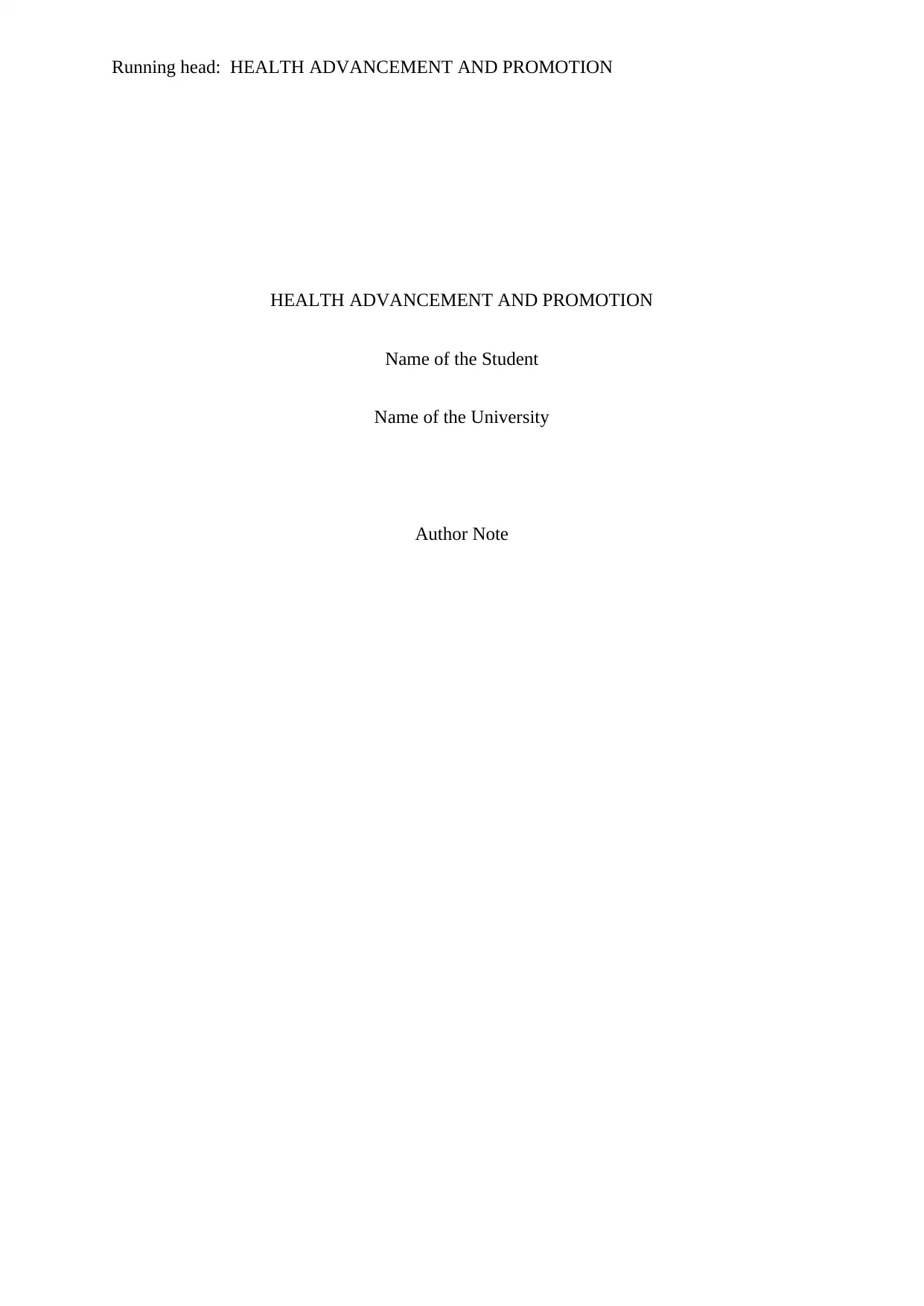
Running head: HEALTH ADVANCEMENT AND PROMOTION
HEALTH ADVANCEMENT AND PROMOTION
Name of the Student
Name of the University
Author Note
HEALTH ADVANCEMENT AND PROMOTION
Name of the Student
Name of the University
Author Note
Paraphrase This Document
Need a fresh take? Get an instant paraphrase of this document with our AI Paraphraser
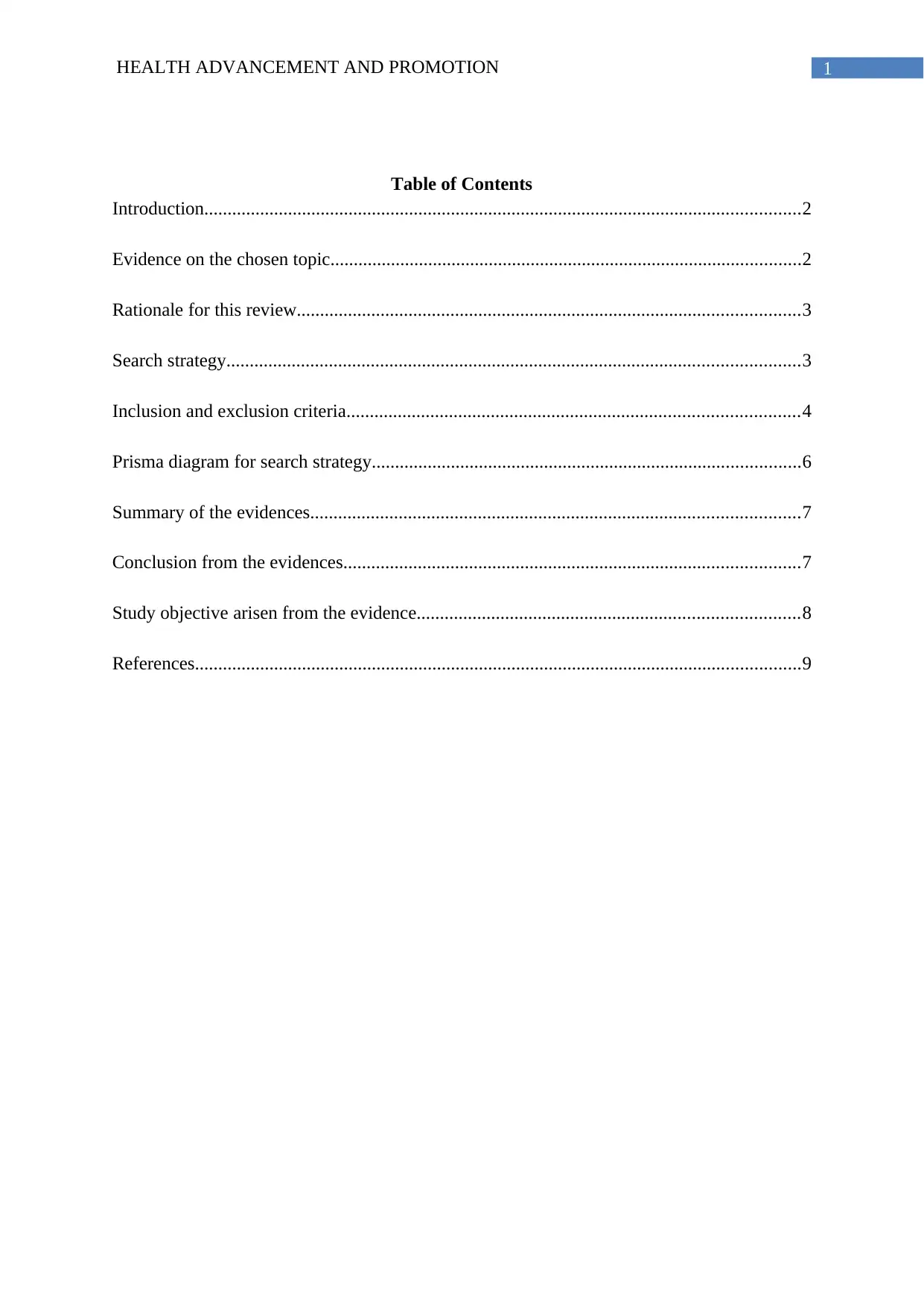
1HEALTH ADVANCEMENT AND PROMOTION
Table of Contents
Introduction................................................................................................................................2
Evidence on the chosen topic.....................................................................................................2
Rationale for this review............................................................................................................3
Search strategy...........................................................................................................................3
Inclusion and exclusion criteria.................................................................................................4
Prisma diagram for search strategy............................................................................................6
Summary of the evidences.........................................................................................................7
Conclusion from the evidences..................................................................................................7
Study objective arisen from the evidence..................................................................................8
References..................................................................................................................................9
Table of Contents
Introduction................................................................................................................................2
Evidence on the chosen topic.....................................................................................................2
Rationale for this review............................................................................................................3
Search strategy...........................................................................................................................3
Inclusion and exclusion criteria.................................................................................................4
Prisma diagram for search strategy............................................................................................6
Summary of the evidences.........................................................................................................7
Conclusion from the evidences..................................................................................................7
Study objective arisen from the evidence..................................................................................8
References..................................................................................................................................9
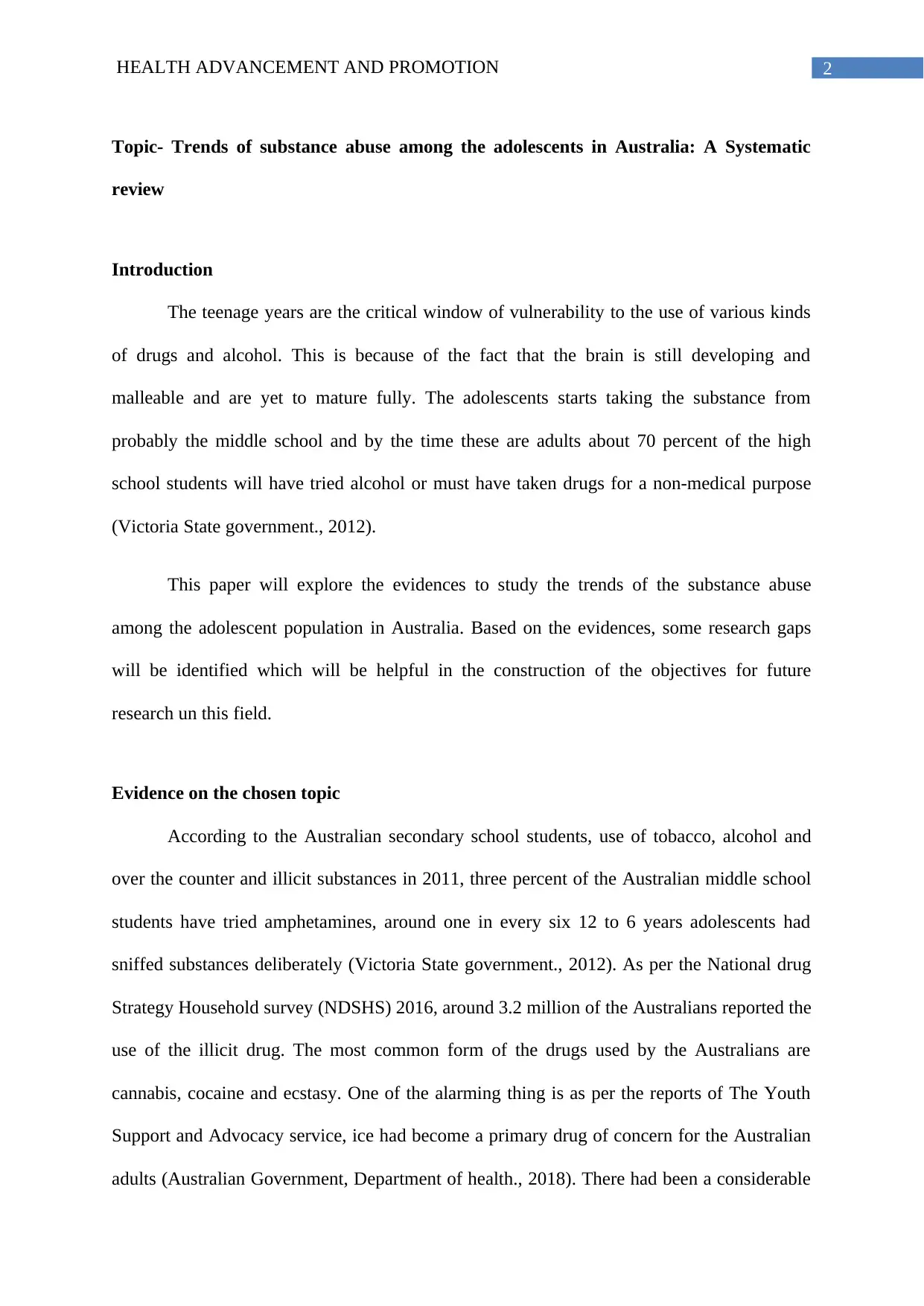
2HEALTH ADVANCEMENT AND PROMOTION
Topic- Trends of substance abuse among the adolescents in Australia: A Systematic
review
Introduction
The teenage years are the critical window of vulnerability to the use of various kinds
of drugs and alcohol. This is because of the fact that the brain is still developing and
malleable and are yet to mature fully. The adolescents starts taking the substance from
probably the middle school and by the time these are adults about 70 percent of the high
school students will have tried alcohol or must have taken drugs for a non-medical purpose
(Victoria State government., 2012).
This paper will explore the evidences to study the trends of the substance abuse
among the adolescent population in Australia. Based on the evidences, some research gaps
will be identified which will be helpful in the construction of the objectives for future
research un this field.
Evidence on the chosen topic
According to the Australian secondary school students, use of tobacco, alcohol and
over the counter and illicit substances in 2011, three percent of the Australian middle school
students have tried amphetamines, around one in every six 12 to 6 years adolescents had
sniffed substances deliberately (Victoria State government., 2012). As per the National drug
Strategy Household survey (NDSHS) 2016, around 3.2 million of the Australians reported the
use of the illicit drug. The most common form of the drugs used by the Australians are
cannabis, cocaine and ecstasy. One of the alarming thing is as per the reports of The Youth
Support and Advocacy service, ice had become a primary drug of concern for the Australian
adults (Australian Government, Department of health., 2018). There had been a considerable
Topic- Trends of substance abuse among the adolescents in Australia: A Systematic
review
Introduction
The teenage years are the critical window of vulnerability to the use of various kinds
of drugs and alcohol. This is because of the fact that the brain is still developing and
malleable and are yet to mature fully. The adolescents starts taking the substance from
probably the middle school and by the time these are adults about 70 percent of the high
school students will have tried alcohol or must have taken drugs for a non-medical purpose
(Victoria State government., 2012).
This paper will explore the evidences to study the trends of the substance abuse
among the adolescent population in Australia. Based on the evidences, some research gaps
will be identified which will be helpful in the construction of the objectives for future
research un this field.
Evidence on the chosen topic
According to the Australian secondary school students, use of tobacco, alcohol and
over the counter and illicit substances in 2011, three percent of the Australian middle school
students have tried amphetamines, around one in every six 12 to 6 years adolescents had
sniffed substances deliberately (Victoria State government., 2012). As per the National drug
Strategy Household survey (NDSHS) 2016, around 3.2 million of the Australians reported the
use of the illicit drug. The most common form of the drugs used by the Australians are
cannabis, cocaine and ecstasy. One of the alarming thing is as per the reports of The Youth
Support and Advocacy service, ice had become a primary drug of concern for the Australian
adults (Australian Government, Department of health., 2018). There had been a considerable
⊘ This is a preview!⊘
Do you want full access?
Subscribe today to unlock all pages.

Trusted by 1+ million students worldwide
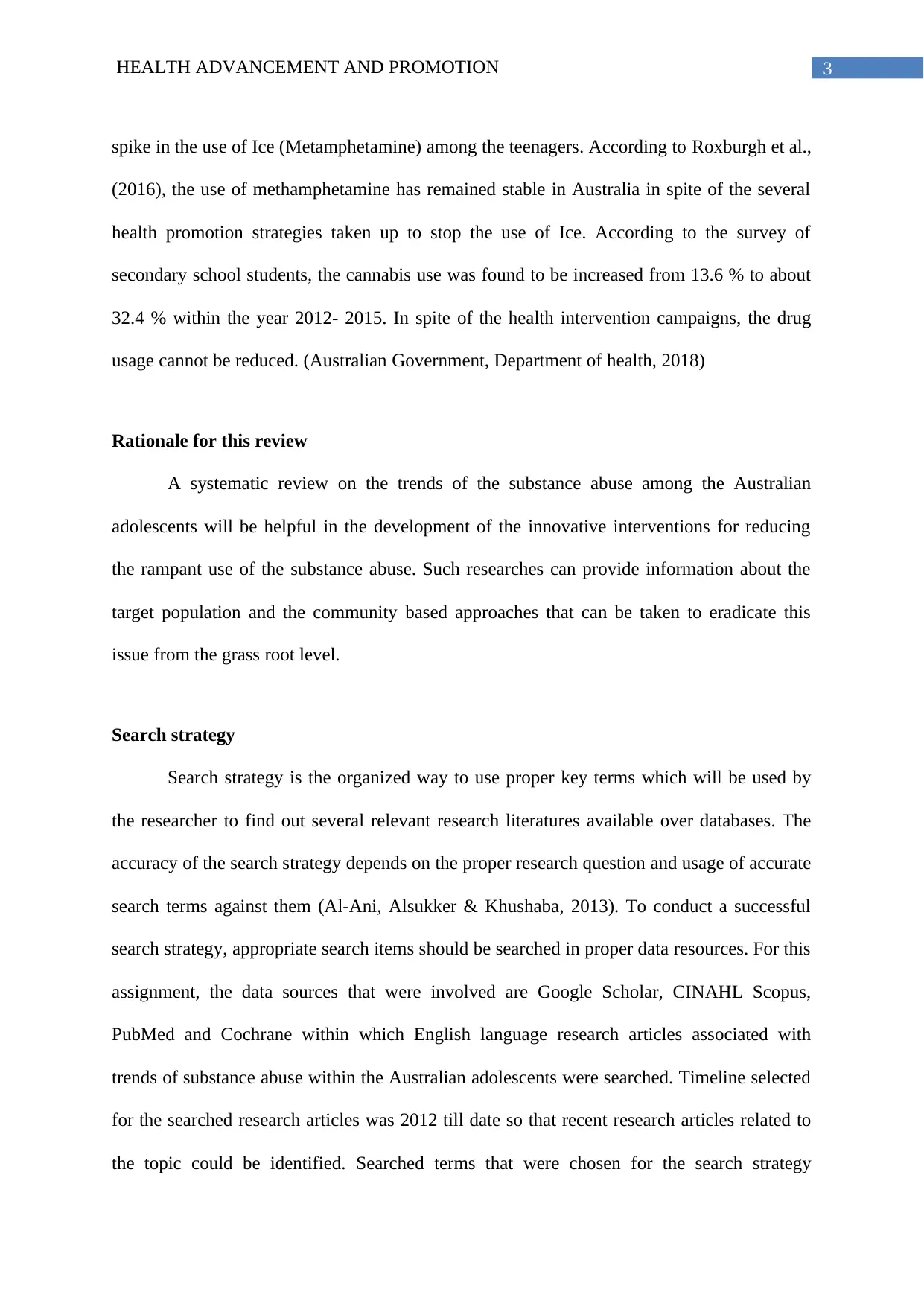
3HEALTH ADVANCEMENT AND PROMOTION
spike in the use of Ice (Metamphetamine) among the teenagers. According to Roxburgh et al.,
(2016), the use of methamphetamine has remained stable in Australia in spite of the several
health promotion strategies taken up to stop the use of Ice. According to the survey of
secondary school students, the cannabis use was found to be increased from 13.6 % to about
32.4 % within the year 2012- 2015. In spite of the health intervention campaigns, the drug
usage cannot be reduced. (Australian Government, Department of health, 2018)
Rationale for this review
A systematic review on the trends of the substance abuse among the Australian
adolescents will be helpful in the development of the innovative interventions for reducing
the rampant use of the substance abuse. Such researches can provide information about the
target population and the community based approaches that can be taken to eradicate this
issue from the grass root level.
Search strategy
Search strategy is the organized way to use proper key terms which will be used by
the researcher to find out several relevant research literatures available over databases. The
accuracy of the search strategy depends on the proper research question and usage of accurate
search terms against them (Al-Ani, Alsukker & Khushaba, 2013). To conduct a successful
search strategy, appropriate search items should be searched in proper data resources. For this
assignment, the data sources that were involved are Google Scholar, CINAHL Scopus,
PubMed and Cochrane within which English language research articles associated with
trends of substance abuse within the Australian adolescents were searched. Timeline selected
for the searched research articles was 2012 till date so that recent research articles related to
the topic could be identified. Searched terms that were chosen for the search strategy
spike in the use of Ice (Metamphetamine) among the teenagers. According to Roxburgh et al.,
(2016), the use of methamphetamine has remained stable in Australia in spite of the several
health promotion strategies taken up to stop the use of Ice. According to the survey of
secondary school students, the cannabis use was found to be increased from 13.6 % to about
32.4 % within the year 2012- 2015. In spite of the health intervention campaigns, the drug
usage cannot be reduced. (Australian Government, Department of health, 2018)
Rationale for this review
A systematic review on the trends of the substance abuse among the Australian
adolescents will be helpful in the development of the innovative interventions for reducing
the rampant use of the substance abuse. Such researches can provide information about the
target population and the community based approaches that can be taken to eradicate this
issue from the grass root level.
Search strategy
Search strategy is the organized way to use proper key terms which will be used by
the researcher to find out several relevant research literatures available over databases. The
accuracy of the search strategy depends on the proper research question and usage of accurate
search terms against them (Al-Ani, Alsukker & Khushaba, 2013). To conduct a successful
search strategy, appropriate search items should be searched in proper data resources. For this
assignment, the data sources that were involved are Google Scholar, CINAHL Scopus,
PubMed and Cochrane within which English language research articles associated with
trends of substance abuse within the Australian adolescents were searched. Timeline selected
for the searched research articles was 2012 till date so that recent research articles related to
the topic could be identified. Searched terms that were chosen for the search strategy
Paraphrase This Document
Need a fresh take? Get an instant paraphrase of this document with our AI Paraphraser
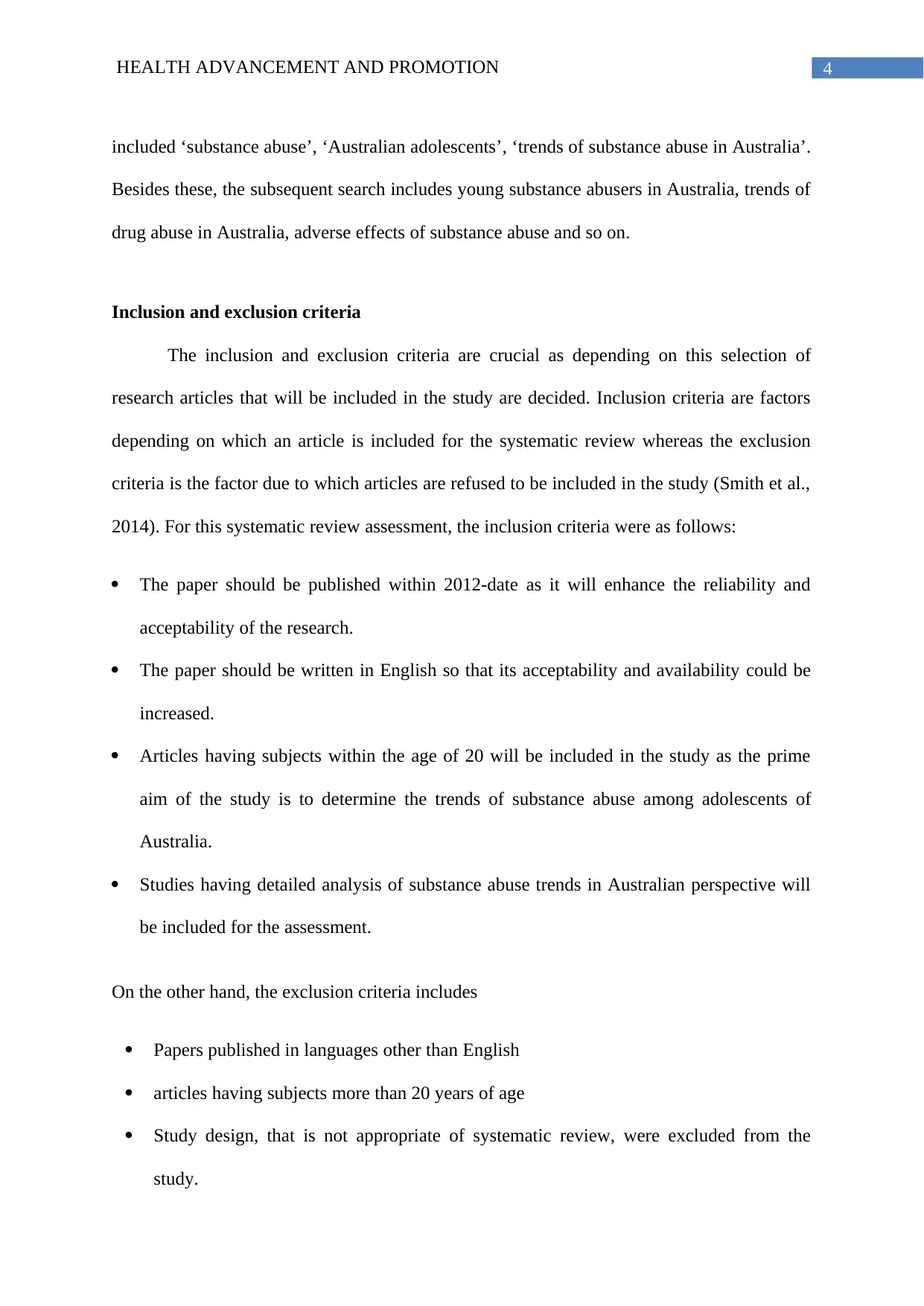
4HEALTH ADVANCEMENT AND PROMOTION
included ‘substance abuse’, ‘Australian adolescents’, ‘trends of substance abuse in Australia’.
Besides these, the subsequent search includes young substance abusers in Australia, trends of
drug abuse in Australia, adverse effects of substance abuse and so on.
Inclusion and exclusion criteria
The inclusion and exclusion criteria are crucial as depending on this selection of
research articles that will be included in the study are decided. Inclusion criteria are factors
depending on which an article is included for the systematic review whereas the exclusion
criteria is the factor due to which articles are refused to be included in the study (Smith et al.,
2014). For this systematic review assessment, the inclusion criteria were as follows:
The paper should be published within 2012-date as it will enhance the reliability and
acceptability of the research.
The paper should be written in English so that its acceptability and availability could be
increased.
Articles having subjects within the age of 20 will be included in the study as the prime
aim of the study is to determine the trends of substance abuse among adolescents of
Australia.
Studies having detailed analysis of substance abuse trends in Australian perspective will
be included for the assessment.
On the other hand, the exclusion criteria includes
Papers published in languages other than English
articles having subjects more than 20 years of age
Study design, that is not appropriate of systematic review, were excluded from the
study.
included ‘substance abuse’, ‘Australian adolescents’, ‘trends of substance abuse in Australia’.
Besides these, the subsequent search includes young substance abusers in Australia, trends of
drug abuse in Australia, adverse effects of substance abuse and so on.
Inclusion and exclusion criteria
The inclusion and exclusion criteria are crucial as depending on this selection of
research articles that will be included in the study are decided. Inclusion criteria are factors
depending on which an article is included for the systematic review whereas the exclusion
criteria is the factor due to which articles are refused to be included in the study (Smith et al.,
2014). For this systematic review assessment, the inclusion criteria were as follows:
The paper should be published within 2012-date as it will enhance the reliability and
acceptability of the research.
The paper should be written in English so that its acceptability and availability could be
increased.
Articles having subjects within the age of 20 will be included in the study as the prime
aim of the study is to determine the trends of substance abuse among adolescents of
Australia.
Studies having detailed analysis of substance abuse trends in Australian perspective will
be included for the assessment.
On the other hand, the exclusion criteria includes
Papers published in languages other than English
articles having subjects more than 20 years of age
Study design, that is not appropriate of systematic review, were excluded from the
study.
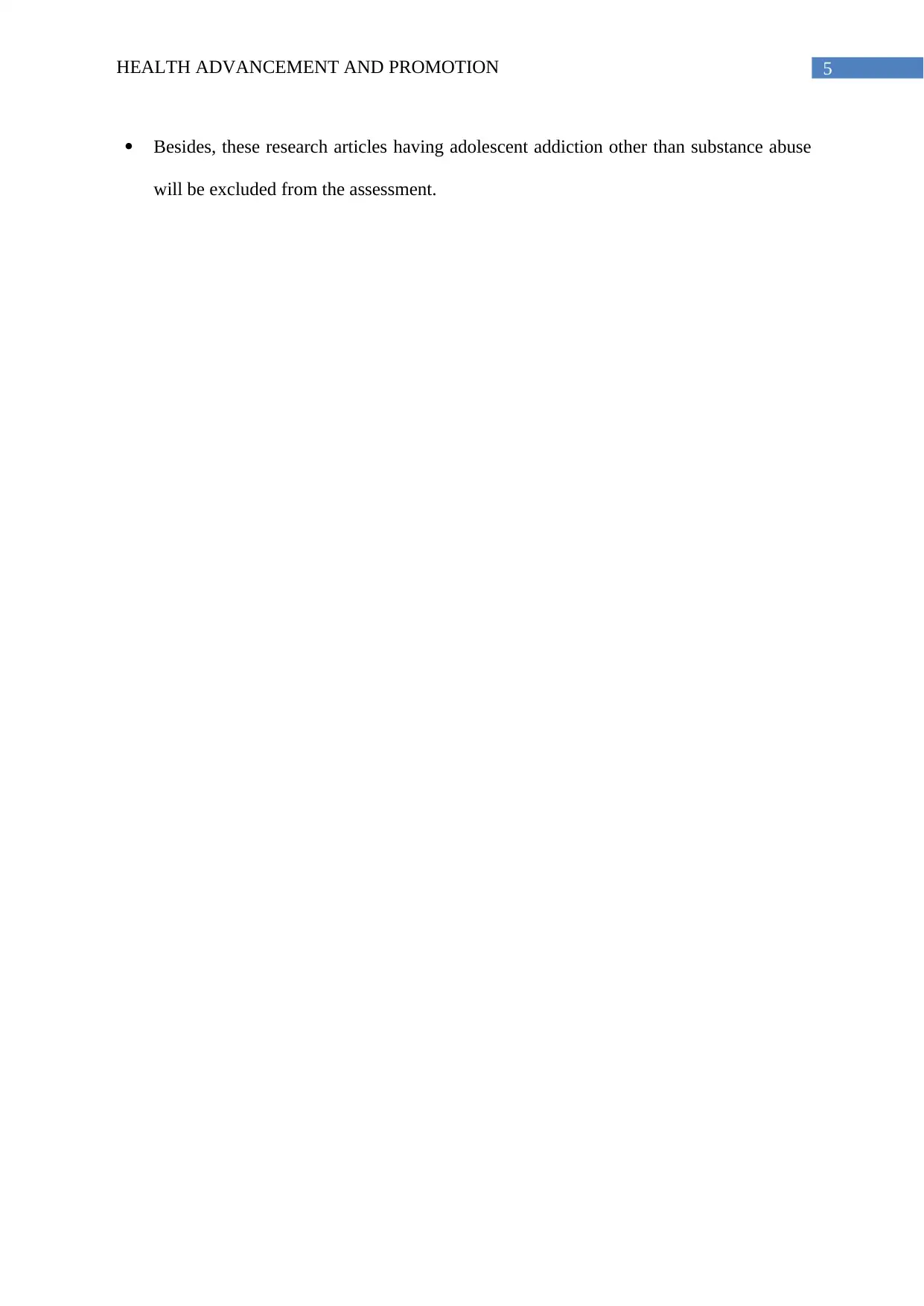
5HEALTH ADVANCEMENT AND PROMOTION
Besides, these research articles having adolescent addiction other than substance abuse
will be excluded from the assessment.
Besides, these research articles having adolescent addiction other than substance abuse
will be excluded from the assessment.
⊘ This is a preview!⊘
Do you want full access?
Subscribe today to unlock all pages.

Trusted by 1+ million students worldwide
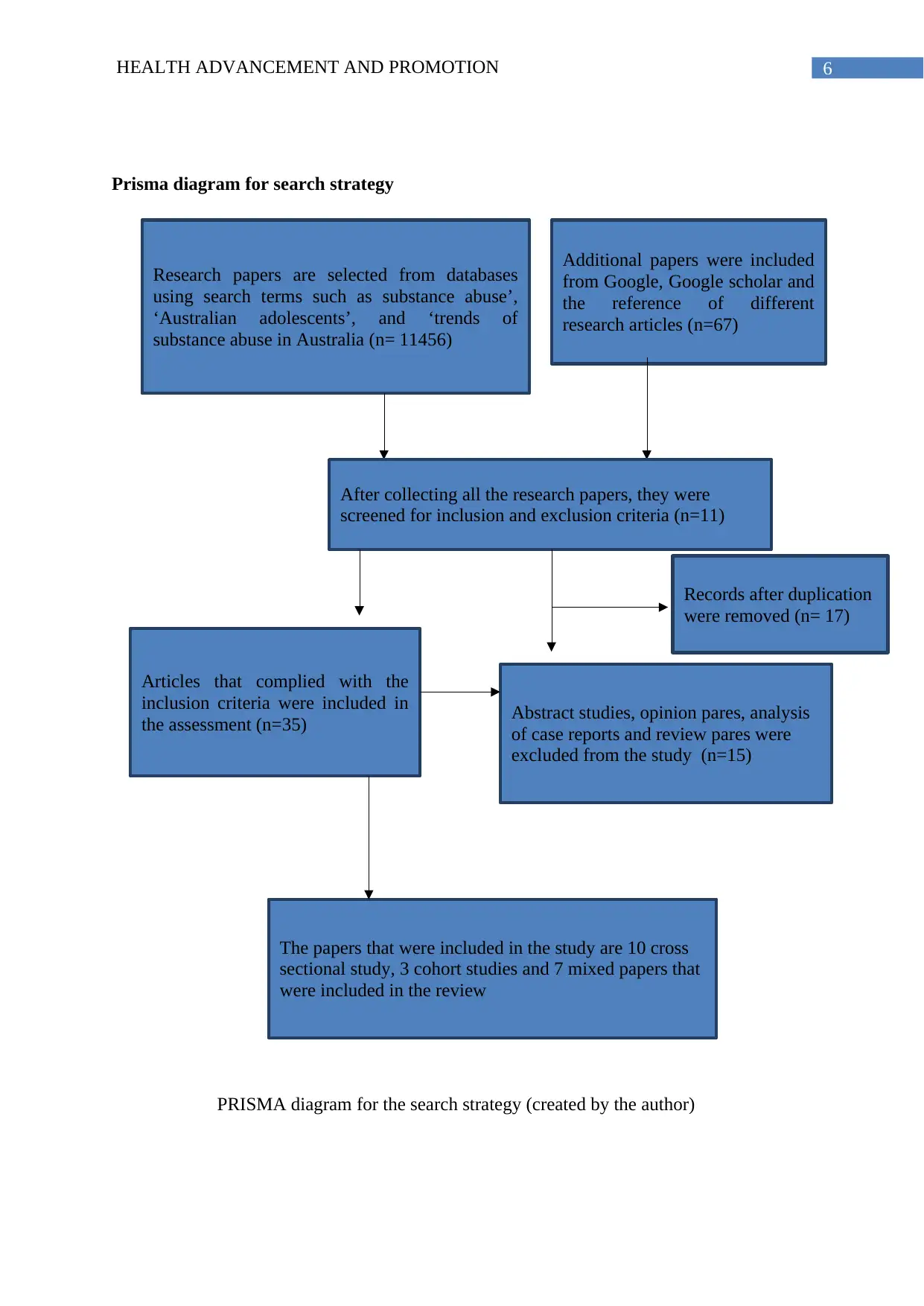
6
Research papers are selected from databases
using search terms such as substance abuse’,
‘Australian adolescents’, and ‘trends of
substance abuse in Australia (n= 11456)
Additional papers were included
from Google, Google scholar and
the reference of different
research articles (n=67)
After collecting all the research papers, they were
screened for inclusion and exclusion criteria (n=11)
Articles that complied with the
inclusion criteria were included in
the assessment (n=35) Abstract studies, opinion pares, analysis
of case reports and review pares were
excluded from the study (n=15)
Records after duplication
were removed (n= 17)
The papers that were included in the study are 10 cross
sectional study, 3 cohort studies and 7 mixed papers that
were included in the review
PRISMA diagram for the search strategy (created by the author)
HEALTH ADVANCEMENT AND PROMOTION
Prisma diagram for search strategy
Research papers are selected from databases
using search terms such as substance abuse’,
‘Australian adolescents’, and ‘trends of
substance abuse in Australia (n= 11456)
Additional papers were included
from Google, Google scholar and
the reference of different
research articles (n=67)
After collecting all the research papers, they were
screened for inclusion and exclusion criteria (n=11)
Articles that complied with the
inclusion criteria were included in
the assessment (n=35) Abstract studies, opinion pares, analysis
of case reports and review pares were
excluded from the study (n=15)
Records after duplication
were removed (n= 17)
The papers that were included in the study are 10 cross
sectional study, 3 cohort studies and 7 mixed papers that
were included in the review
PRISMA diagram for the search strategy (created by the author)
HEALTH ADVANCEMENT AND PROMOTION
Prisma diagram for search strategy
Paraphrase This Document
Need a fresh take? Get an instant paraphrase of this document with our AI Paraphraser
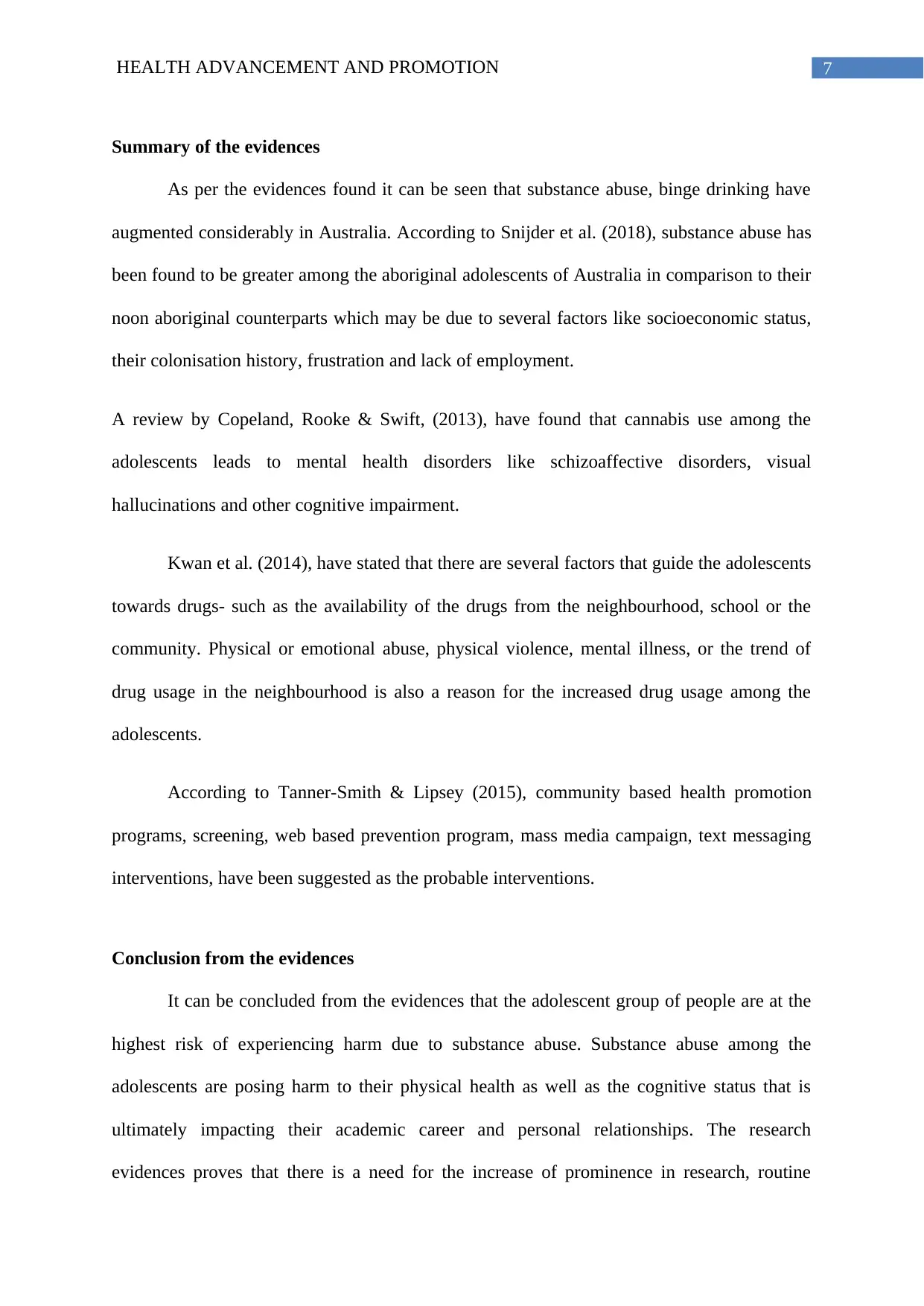
7HEALTH ADVANCEMENT AND PROMOTION
Summary of the evidences
As per the evidences found it can be seen that substance abuse, binge drinking have
augmented considerably in Australia. According to Snijder et al. (2018), substance abuse has
been found to be greater among the aboriginal adolescents of Australia in comparison to their
noon aboriginal counterparts which may be due to several factors like socioeconomic status,
their colonisation history, frustration and lack of employment.
A review by Copeland, Rooke & Swift, (2013), have found that cannabis use among the
adolescents leads to mental health disorders like schizoaffective disorders, visual
hallucinations and other cognitive impairment.
Kwan et al. (2014), have stated that there are several factors that guide the adolescents
towards drugs- such as the availability of the drugs from the neighbourhood, school or the
community. Physical or emotional abuse, physical violence, mental illness, or the trend of
drug usage in the neighbourhood is also a reason for the increased drug usage among the
adolescents.
According to Tanner-Smith & Lipsey (2015), community based health promotion
programs, screening, web based prevention program, mass media campaign, text messaging
interventions, have been suggested as the probable interventions.
Conclusion from the evidences
It can be concluded from the evidences that the adolescent group of people are at the
highest risk of experiencing harm due to substance abuse. Substance abuse among the
adolescents are posing harm to their physical health as well as the cognitive status that is
ultimately impacting their academic career and personal relationships. The research
evidences proves that there is a need for the increase of prominence in research, routine
Summary of the evidences
As per the evidences found it can be seen that substance abuse, binge drinking have
augmented considerably in Australia. According to Snijder et al. (2018), substance abuse has
been found to be greater among the aboriginal adolescents of Australia in comparison to their
noon aboriginal counterparts which may be due to several factors like socioeconomic status,
their colonisation history, frustration and lack of employment.
A review by Copeland, Rooke & Swift, (2013), have found that cannabis use among the
adolescents leads to mental health disorders like schizoaffective disorders, visual
hallucinations and other cognitive impairment.
Kwan et al. (2014), have stated that there are several factors that guide the adolescents
towards drugs- such as the availability of the drugs from the neighbourhood, school or the
community. Physical or emotional abuse, physical violence, mental illness, or the trend of
drug usage in the neighbourhood is also a reason for the increased drug usage among the
adolescents.
According to Tanner-Smith & Lipsey (2015), community based health promotion
programs, screening, web based prevention program, mass media campaign, text messaging
interventions, have been suggested as the probable interventions.
Conclusion from the evidences
It can be concluded from the evidences that the adolescent group of people are at the
highest risk of experiencing harm due to substance abuse. Substance abuse among the
adolescents are posing harm to their physical health as well as the cognitive status that is
ultimately impacting their academic career and personal relationships. The research
evidences proves that there is a need for the increase of prominence in research, routine
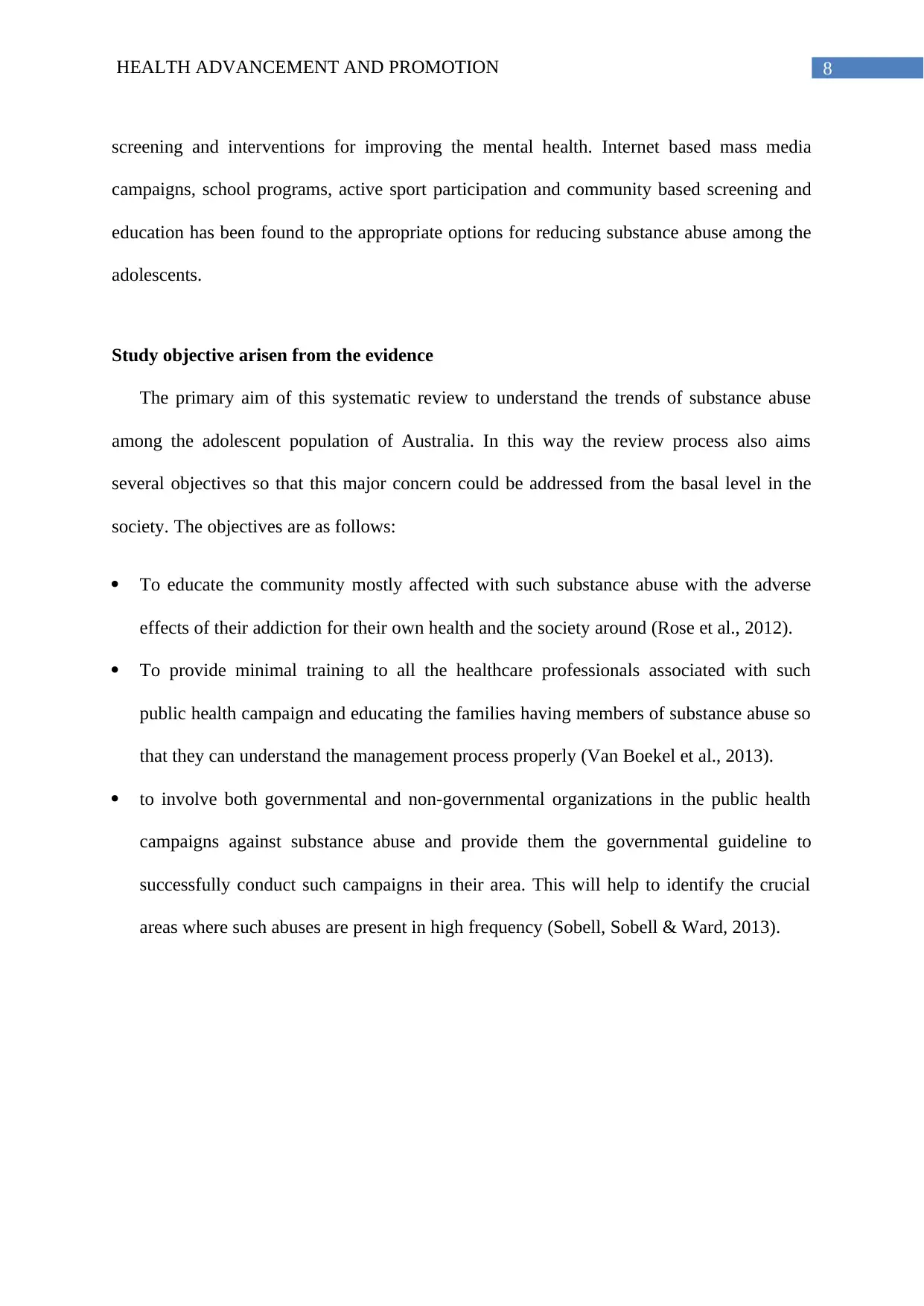
8HEALTH ADVANCEMENT AND PROMOTION
screening and interventions for improving the mental health. Internet based mass media
campaigns, school programs, active sport participation and community based screening and
education has been found to the appropriate options for reducing substance abuse among the
adolescents.
Study objective arisen from the evidence
The primary aim of this systematic review to understand the trends of substance abuse
among the adolescent population of Australia. In this way the review process also aims
several objectives so that this major concern could be addressed from the basal level in the
society. The objectives are as follows:
To educate the community mostly affected with such substance abuse with the adverse
effects of their addiction for their own health and the society around (Rose et al., 2012).
To provide minimal training to all the healthcare professionals associated with such
public health campaign and educating the families having members of substance abuse so
that they can understand the management process properly (Van Boekel et al., 2013).
to involve both governmental and non-governmental organizations in the public health
campaigns against substance abuse and provide them the governmental guideline to
successfully conduct such campaigns in their area. This will help to identify the crucial
areas where such abuses are present in high frequency (Sobell, Sobell & Ward, 2013).
screening and interventions for improving the mental health. Internet based mass media
campaigns, school programs, active sport participation and community based screening and
education has been found to the appropriate options for reducing substance abuse among the
adolescents.
Study objective arisen from the evidence
The primary aim of this systematic review to understand the trends of substance abuse
among the adolescent population of Australia. In this way the review process also aims
several objectives so that this major concern could be addressed from the basal level in the
society. The objectives are as follows:
To educate the community mostly affected with such substance abuse with the adverse
effects of their addiction for their own health and the society around (Rose et al., 2012).
To provide minimal training to all the healthcare professionals associated with such
public health campaign and educating the families having members of substance abuse so
that they can understand the management process properly (Van Boekel et al., 2013).
to involve both governmental and non-governmental organizations in the public health
campaigns against substance abuse and provide them the governmental guideline to
successfully conduct such campaigns in their area. This will help to identify the crucial
areas where such abuses are present in high frequency (Sobell, Sobell & Ward, 2013).
⊘ This is a preview!⊘
Do you want full access?
Subscribe today to unlock all pages.

Trusted by 1+ million students worldwide
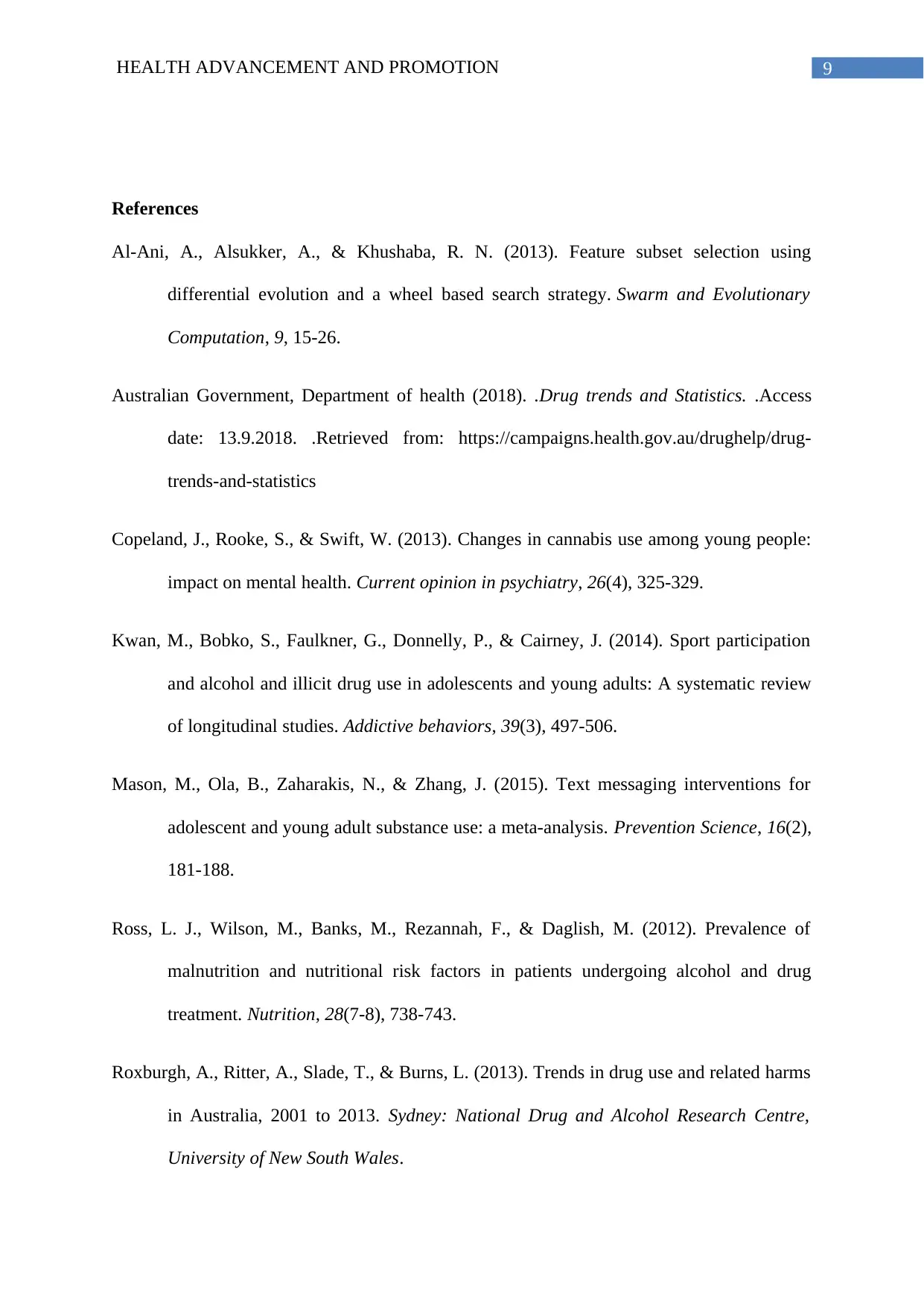
9HEALTH ADVANCEMENT AND PROMOTION
References
Al-Ani, A., Alsukker, A., & Khushaba, R. N. (2013). Feature subset selection using
differential evolution and a wheel based search strategy. Swarm and Evolutionary
Computation, 9, 15-26.
Australian Government, Department of health (2018). .Drug trends and Statistics. .Access
date: 13.9.2018. .Retrieved from: https://campaigns.health.gov.au/drughelp/drug-
trends-and-statistics
Copeland, J., Rooke, S., & Swift, W. (2013). Changes in cannabis use among young people:
impact on mental health. Current opinion in psychiatry, 26(4), 325-329.
Kwan, M., Bobko, S., Faulkner, G., Donnelly, P., & Cairney, J. (2014). Sport participation
and alcohol and illicit drug use in adolescents and young adults: A systematic review
of longitudinal studies. Addictive behaviors, 39(3), 497-506.
Mason, M., Ola, B., Zaharakis, N., & Zhang, J. (2015). Text messaging interventions for
adolescent and young adult substance use: a meta-analysis. Prevention Science, 16(2),
181-188.
Ross, L. J., Wilson, M., Banks, M., Rezannah, F., & Daglish, M. (2012). Prevalence of
malnutrition and nutritional risk factors in patients undergoing alcohol and drug
treatment. Nutrition, 28(7-8), 738-743.
Roxburgh, A., Ritter, A., Slade, T., & Burns, L. (2013). Trends in drug use and related harms
in Australia, 2001 to 2013. Sydney: National Drug and Alcohol Research Centre,
University of New South Wales.
References
Al-Ani, A., Alsukker, A., & Khushaba, R. N. (2013). Feature subset selection using
differential evolution and a wheel based search strategy. Swarm and Evolutionary
Computation, 9, 15-26.
Australian Government, Department of health (2018). .Drug trends and Statistics. .Access
date: 13.9.2018. .Retrieved from: https://campaigns.health.gov.au/drughelp/drug-
trends-and-statistics
Copeland, J., Rooke, S., & Swift, W. (2013). Changes in cannabis use among young people:
impact on mental health. Current opinion in psychiatry, 26(4), 325-329.
Kwan, M., Bobko, S., Faulkner, G., Donnelly, P., & Cairney, J. (2014). Sport participation
and alcohol and illicit drug use in adolescents and young adults: A systematic review
of longitudinal studies. Addictive behaviors, 39(3), 497-506.
Mason, M., Ola, B., Zaharakis, N., & Zhang, J. (2015). Text messaging interventions for
adolescent and young adult substance use: a meta-analysis. Prevention Science, 16(2),
181-188.
Ross, L. J., Wilson, M., Banks, M., Rezannah, F., & Daglish, M. (2012). Prevalence of
malnutrition and nutritional risk factors in patients undergoing alcohol and drug
treatment. Nutrition, 28(7-8), 738-743.
Roxburgh, A., Ritter, A., Slade, T., & Burns, L. (2013). Trends in drug use and related harms
in Australia, 2001 to 2013. Sydney: National Drug and Alcohol Research Centre,
University of New South Wales.
Paraphrase This Document
Need a fresh take? Get an instant paraphrase of this document with our AI Paraphraser

10HEALTH ADVANCEMENT AND PROMOTION
Smith, M. B., Nelson, H. D., Haney, E., Pappas, M., Daeges, M., Wasson, N., & McDonagh,
M. (2014). Inclusion and Exclusion Criteria.
Snijder, M., Stapinski, L., Lees, B., Newton, N., Champion, K., Chapman, C., … Teesson, M.
(2018). Substance Use Prevention Programs for Indigenous Adolescents in the United
States of America, Canada, Australia and New Zealand: Protocol for a Systematic
Review. JMIR Research Protocols, 7(2), e38. http://doi.org/10.2196/resprot.9012
Sobell, L. C., Sobell, M. B., & Ward, E. (Eds.). (2013). Evaluating alcohol and drug abuse
treatment effectiveness: Recent advances. Elsevier.
Tanner-Smith, E. E., & Lipsey, M. W. (2015). Brief alcohol interventions for adolescents and
young adults: A systematic review and meta-analysis. Journal of substance abuse
treatment, 51, 1-18.
Van Boekel, L. C., Brouwers, E. P., Van Weeghel, J., & Garretsen, H. F. (2013). Stigma
among health professionals towards patients with substance use disorders and its
consequences for healthcare delivery: systematic review. Drug and alcohol
dependence, 131(1-2), 23-35.
Victoria State government. (2012).Drugs and teenagers. Access date: 13.9.2018. .Retrieved
from: https://www.betterhealth.vic.gov.au/health/HealthyLiving/drugs-teenagers
Smith, M. B., Nelson, H. D., Haney, E., Pappas, M., Daeges, M., Wasson, N., & McDonagh,
M. (2014). Inclusion and Exclusion Criteria.
Snijder, M., Stapinski, L., Lees, B., Newton, N., Champion, K., Chapman, C., … Teesson, M.
(2018). Substance Use Prevention Programs for Indigenous Adolescents in the United
States of America, Canada, Australia and New Zealand: Protocol for a Systematic
Review. JMIR Research Protocols, 7(2), e38. http://doi.org/10.2196/resprot.9012
Sobell, L. C., Sobell, M. B., & Ward, E. (Eds.). (2013). Evaluating alcohol and drug abuse
treatment effectiveness: Recent advances. Elsevier.
Tanner-Smith, E. E., & Lipsey, M. W. (2015). Brief alcohol interventions for adolescents and
young adults: A systematic review and meta-analysis. Journal of substance abuse
treatment, 51, 1-18.
Van Boekel, L. C., Brouwers, E. P., Van Weeghel, J., & Garretsen, H. F. (2013). Stigma
among health professionals towards patients with substance use disorders and its
consequences for healthcare delivery: systematic review. Drug and alcohol
dependence, 131(1-2), 23-35.
Victoria State government. (2012).Drugs and teenagers. Access date: 13.9.2018. .Retrieved
from: https://www.betterhealth.vic.gov.au/health/HealthyLiving/drugs-teenagers
1 out of 11
Related Documents
Your All-in-One AI-Powered Toolkit for Academic Success.
+13062052269
info@desklib.com
Available 24*7 on WhatsApp / Email
![[object Object]](/_next/static/media/star-bottom.7253800d.svg)
Unlock your academic potential
Copyright © 2020–2025 A2Z Services. All Rights Reserved. Developed and managed by ZUCOL.




